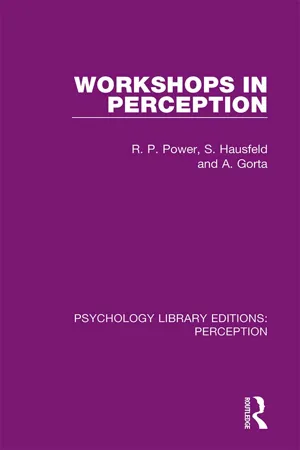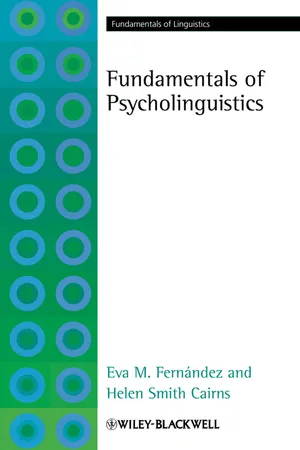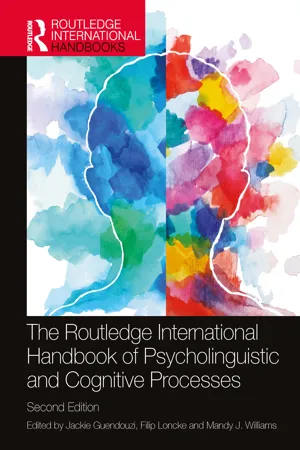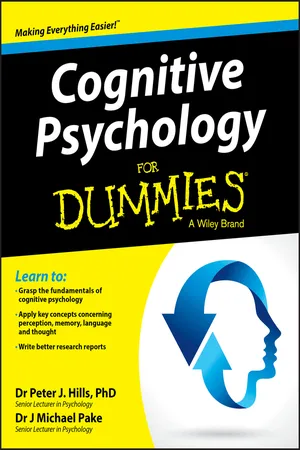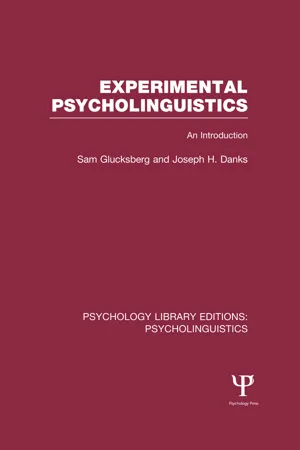Psychology
Language and Perception
Language and perception are interconnected in psychology, as language influences how individuals perceive and interpret the world around them. The words and language structures people use can shape their perceptions, influencing their thoughts and behaviors. Additionally, perception can also impact language, as individuals may use language to express their perceptions and experiences.
Written by Perlego with AI-assistance
Related key terms
Related key terms
1 of 4
Related key terms
1 of 3
8 Key excerpts on "Language and Perception"
- eBook - ePub
- Rod Power, Steven Hausfeld, Angela Gorta(Authors)
- 2017(Publication Date)
- Routledge(Publisher)
Perception of languageLanguage plays a vital role in the lives of all of us. Certainly we would not be writing this and you would not be reading it but for our ability to perceive language. The use of language has even been proposed as the factor which distinguishes man from the other animals In studying our use of language psychologists cover both perceptual and more cognitive topics. The more perceptual topics include the range of frequencies in speech and the likely effects of a hearing deficit in a specific frequency range, the question of whether or not there is a specific perceptual apparatus to deal with speech as opposed to other auditory stimuli (Mattingly, Liberman, Syrdal and Halwes, 1971), and the pattern of saccadic eye movements in reading. This pattern of eye movements is interesting because it highlights the fact that we are effectively blind during the saccadic jumps our eyes make from one fixation to the next. We actually make about four to six such fixations along each line of text. Thus our impression of scanning continuously along the line of print is somewhat illusory. More cognitive questions about language include how we integrate information across sentences and the way that the grammatical structure of sentences affects our processing of them. Although there is no sharp distinction between perceptual and cognitive topics here, we have tried to choose workshops which are more perceptual than cognitive.So far we have discussed the perception of language as though it covered only listening to speech and reading. However, the topic also embraces activities such as perceiving hand sign languages of the deaf (Wilbur, 1979), lipreading (Berger, 1972), and perhaps even perceiving body language and gestures (Critchley, 1975; Lamb and Watson, 1979). Wilbur points out that handsign languages, such as American Sign Language, actually share with spoken language many general syntactic and semantic similarities, and that they too derive some meaning from context. As Critchley shows, gestures and body position can be used to act out stories as in a mime, to communicate particular statements or instructions, such as ‘Come here!’, or to indicate one’s general mood or style. With regard to lipreading, one alternative in Workshop 27 suggests that some aspects of lipreading can play an important part in face-to-face speech perception even for hearing people. - eBook - ePub
Human Communication
Theoretical Explorations
- Albert Silverstein(Author)
- 2015(Publication Date)
- Routledge(Publisher)
These two developments-the scholarly study of language and the creation of a vast technology of communication-seem to have begun as independent manifestations of the spirit of our times. But with the emergence of digital computers as language-processing systems, the world of the academy and the world of technology joined forces in their attempts to understand the nature of language and communication. Indeed, in order to communicate with our computers, a whole new class of artificial languages had to be invented. Each decade seems to bring some new advance, to open some new possibilities.Thus, psychologists interested in language and communication feel themselves to be part of a much larger army of workers contributing to the purification of ideas that rank among the great triumphs of the modern mind. This feeling lends an excitement to the field that is often difficult for outsiders to comprehend. It means that the zoologist who records the grunts and gestures of the great apes, or the psychologist who analyzes the almost unintelligible utterances of young children, or the neurologist who studies aphasia or stimulates the centers in the brain that control speech, or the engineer who designs telephone circuits to transmit the human voice more efficiently, or the grammarian who states rules for forming grammatical sentences, or the logician who analyzes the way we should use words like "some," "all," and "none," or the philosopher who tries to untangle linguistic sources of philosophical confusion, or the sociologist who measures social effects of mass media of communication — all these workers and many others can see themselves as participating in and contributing to one of the great intellectual adventures of the twentieth century. Seen in isolation, anyone of these studies might seem uninteresting, even pointless. Taken all together, they point to a concern for language and communication as among the principal intellectual preoccupations of our time.The central object of all this interest and excitement, of course, is human language. Since I have carefully defined "psychology" and "communication," I must now try to say what "language" means.There seem to be at least two different ways to define what a language is. According to one definition, a language is a socially shared means for expressing ideas. I would call this a functional definition, because it is stated in terms of a function that language serves. Another definition says that a language is all the well-formed sentences that could be generated according to the rules of its grammar. I would call this a formal - eBook - ePub
- Eva M. Fernández, Helen Smith Cairns(Authors)
- 2010(Publication Date)
- Wiley-Blackwell(Publisher)
1 Beginning ConceptsThe Creativity of Human Language Language as Distinct from Speech, Thought, and Communication Some Characteristics of the Linguistic System The Distinction between Descriptive and Prescriptive Grammar The Universality of Human Language Implications for the Acquisition of Language How Language Pairs Sound and Meaning Linguistic Competence and Linguistic Performance The Speech Signal and Linguistic Perception Origins of Contemporary Psycholinguistics How This Book Is Organized New Concepts Study QuestionsPsycholinguistics is an interdisciplinary field of study in which the goals are to understand how people acquire language, how people use language to speak and understand one another, and how language is represented and processed in the brain. Psycholinguistics is primarily a sub-discipline of psychology and linguistics, but it is also related to developmental psychology, cognitive psychology, neurolinguistics, and speech science. The purpose of this book is to introduce the reader to some of the central ideas, problems, and discoveries in contemporary psycholinguistics. In this chapter, we explore key concepts about language that serve to distinguish it from related aspects of human behavior and cognition, and we identify the basic characteristics of language as a system. We also provide a brief account of how psycholinguistics emerged as a field of inquiry.The Creativity of Human LanguageA good place to begin is by thinking about some of the unique features of human language. Language is a system that allows people immense creativity - eBook - ePub
Interpersonal Communication
Competence and Contexts
- Shelley D. Lane(Author)
- 2016(Publication Date)
- Routledge(Publisher)
IIllusionist David Copperfield influences his audiences to perceive that he can levitate across the Grand Canyon, escape from Alcatraz Island, and make the Statue of Liberty disappear. What factors affect how we perceive and what we perceive as “real”? Do you or someone you know perceive that “all [fill in the blank with a particular group] are [fill in the blank with an adjective]”? Have you and a partner ever argued about whose perceptions are correct? In reality, perceptual differences don’t necessarily mean that one person’s version of “truth” is better than another’s. Try to recall some instances of perceptual disagreement as you read the material in this chapter regarding perception in general and how our perceptions of others influence our interpersonal communication. In this chapter, we will increase our motivation to communicate competently by learning why it’s important to study perception and communication. Engaging in perspective taking can increase our motivation to communicate with others who are different from us. We will also increase our knowledge by learning about the characterization of perception, the stages in the perception process, how our perception of reality is biased, how our perception is influenced by contexts, and the challenges of perception and communication as they relate to stereotyping and prejudice. Finally, we will learn two skills that can improve our interactions with others—how to communicate descriptive rather than inferential statements, and how to engage in the skill of perception checking.Introduction to Perception
Have you ever misjudged the distance between you and another person or something that is inanimate (and therefore accidentally bumped into someone or walked into a wall)? Have you ever thought that someone “looked” unintelligent but revised your opinion after speaking with her or him? These questions concern perception. Perception is learned; it isn’t an innate ability. Perception occurs when sense data—what we see, hear, smell, taste, and/or touch—is transmitted to the brain. The brain almost instantly transforms the sensory messages into conscious perceptions by attaching meaning to the sense data. This process occurs in three stages.Perception is the process of selecting, organizing, and interpreting sensory information. “Seeing” is not the same as “perceiving.” A man who regained his sight after thirty years of blindness makes clear the difference between sight and perception: “When I could see again, objects literally hurled themselves at me. One of the things a normal person knows from long habit is what not to look at. Things that don’t matter, or that confuse, are simply shut out of their seeing minds. I had forgotten this, and tried to see everything at once; consequently I saw nothing.”1 - Jackie Guendouzi, Filip Loncke, Mandy J. Williams(Authors)
- 2023(Publication Date)
- Routledge(Publisher)
The field of psycholinguistics has yielded many diverse and competing theories over the years; some more than others have dominated language research. As seen in this text, there are multiple approaches to the question of how we process language. Readers should draw their own conclusions as to the robustness of specific models or theories; exploring theoretical questions is an ongoing process that rarely arrives at a definitive answer, there is always more to discover. As with the first edition, we feel it is helpful to start the introduction by providing some historical context to the field of psycholinguistics and its relationship with communication disorders.Psycholinguistics: A historical perspective
Psycholinguistics has always involved the art of finding models to help us understand why and how people speak, listen, read, and write. In some of the earliest reflections on language and speech, it raises questions that still spark the interest of scholars to this day. Plato’s Cratylus (Sedley, 2003 ) discusses the relationship between words and their referents, an issue that has remained central both in developmental accounts of language (Piaget, 1929/1997 ) and its disorders and in the field of cognitive semantics (Evan & Green, 2006 ).A general fascination with language, where it came from, its potential synaptic plasticity, and its disorders is reflected in discussions from the time of the Enlightenment on. Twentieth-century linguists explicitly trace back their line of thinking to Descartes’s reasoning on the nature of ideas and mental functioning (Chomsky, 1966 ).The 19th century was the time of the precursors of our understanding of the neurolinguistic underpinnings of language, starting with Gall’s speculation of the brain’s mental areas to Broca’s and Wernicke’s description of types of aphasia. Theories about localization led to a rudimentary psycholinguistic theory, most notably reflected in the Wernicke/Lichtheim model (Caplan, 1987 ). This model assumed the existence of an (anatomically based) system of connections between brain centers; problems in processing language were described as a breakdown, a deletion, or a distortion in the communication system. The Wernicke/Lichtheim classification may be considered the earliest model of internal linguistic processing, combining a brain localization approach with an information processing approach. The study of aphasia also led to the first classifications and distinctions between subcomponents of language and language processing. The terms motor aphasia, conduction aphasia, receptive aphasia, and transcortical aphasia reflect an attempt to grasp both the internal organization of language and its interaction with the brain. For a century and a half, these distinctions have been a basis on which intervention rationales have been built. At the same time, already in the early 20th century, the accuracy of these approaches was challenged and criticized. These early neurolinguistics models served as a framework to understand language disorders in children: Until the 1970s childhood language problems were often referred to as developmental dysphasia (Wyke, 1978- eBook - ePub
- Peter J. Hills, Michael Pake(Authors)
- 2016(Publication Date)
- For Dummies(Publisher)
pre-operational stage). At this level children who’re able to verbalise relationships between two things (such as ‘bigger than’) can solve problems that involve such relationships. In contrast, children who can’t verbalise the relationship can’t solve the problem. Thus, the necessary cognitive ability requires the language.General cognitive development and language ability are developing at the same time, however, and so separating the two is difficult. Saying this, Piaget believed that language develops because of cognitive development, suggesting a cyclical relationship between language and cognition.One useful method for assessing how language affects thought is to test people who don’t have language. New-born infants haven’t developed language yet and so are ideal participants.Research on children has tended to explore colour perception and categorical perception (refer to the two preceding sections). Many studies show that children find it harder to discriminate between colours for which they don’t have verbal labels. In addition, categorical perception boundaries aren’t so readily identifiable in children.Although some developmental changes in the perception of colour may exist, the focal colours (the 11 basic colour terms of English, including red and blue; see Chapter 5 ) do appear to be learnt earlier without words.Covering other cognitive abilities
Here we provide more evidence of how language affects thought.The way people label objects affects the accuracy with which they’re recognised. In one experiment, participants were presented with a series of fairly ambiguous objects that had been labelled or not. Labelling aided memory for the ambiguous objects, suggesting that language helps memory.When presented with a series of shapes to remember, if participants verbally label based on distinctive labels (for example, crescent), they’re more likely to remember them than if participants verbally label based on common shared labels (for example, square). This is consistent with the weak form of the Sapir–Whorf hypothesis, because the language used has affected memory (refer to the earlier section ‘Connecting language to thought - eBook - ePub
- Pierre Oléron, Raymond P. Lorion(Authors)
- 2021(Publication Date)
- Routledge(Publisher)
3Language and Cognition
This chapter consists of two sections. In the first, we shall consider those elements of development that do not depend on language. The aim is not to describe these processes in extensive detail; such a project is beyond the scope of this volume. Rather an attempt will be made to present and illustrate the major trends in this body of data. The examples described were selected from areas in which one would anticipate language’s involvement. Empirical findings, however, often do not support this expectation, as will be demonstrated in the examples presented.The second portion of the chapter focuses upon the other side of the coin—those areas of development that depend on language. Two categories of such processes shall be considered which we have labeled instrumental and indirect. Once the major trends in this area have been presented, these two types of intervention shall be analyzed more specifically in terms of their relationships to elements of cognitive development. Since, in our view, the indirect approach is the more important of the two, it will receive particular attention.PRELANGUAGE POTENTIAL
The Preverbal Bases of Cognitive Development
In part, cognitive development occurs within a system of responses to perceived stimuli. As a result of maturation and experience, this system becomes increasingly relevant to behavior. Language’s role in this stage of growth, however, is suspect since its involvement begins late in the sequence.The most primitive and basic forms of cognition focus upon objects the subject perceives and manipulates. At this stage, the organism displays the limits of his abilities and discovers that some are quite rudimentary, while others have already reached an impressive degree of development. Already what seem to be strictly perceptual skills provide a rich and detailed framework within which the subject automatically categorizes objects, estimates distances, and recognizes constancies of size, form, and so on. Careful, deliberate thought is not necessary for these procedures, nor is symbolic activity required (even though methods of analysis made more sophisticated by language may intervene later in difficult situations). - eBook - ePub
Experimental Psycholinguistics (PLE: Psycholinguistics)
An Introduction
- Sam Glucksberg, Joseph H. Danks(Authors)
- 2013(Publication Date)
- Psychology Press(Publisher)
the process in which functions previously shared between two persons gradually change into the complicated functional systems in the mind which forms the essence of human higher mental activity [p. 18].” In American psychology too, cognitive development is linked to speech development. In particular, the ability of children to perform various conceptual tasks is attributed to their ability to use verbal mediation (see Kendler & Kendler, 1962). If speech or language is so crucial to thought, or at least to the development of thought, then children who are deprived of speech should be severely retarded. Yet this is by no means the case. Deaf children are often brought up without a formal language system, not even a sign language. They do, of course, have interpersonal contact with others, and presumably communication with others. In general, the cognitive abilities of deaf children and deaf adults are not significantly different from those of normal hearing children and adults (Furth, 1966). If speech or language per se is not crucial to intellectual development, then what is? We would argue that the most important developmental task for children is the construction of a symbolic representation of the world—people, events, objects, and relationships—and the ability to operate with and upon those representations. In general terms, we call this system of symbolic representation KNOWLEDGE OF THE WORLD. Speech per se is not necessarily crucial to the acquisition or development of symbolic representation, but interpersonal communication is. Whether overt speech or a formal sign language is available to a child or not, he learns about the world partly from his own experiences, and partly from what others tell him about it. Overt speech seems so important because it is so easily noticed and observed
Index pages curate the most relevant extracts from our library of academic textbooks. They’ve been created using an in-house natural language model (NLM), each adding context and meaning to key research topics.
Explore more topic indexes
Explore more topic indexes
1 of 6
Explore more topic indexes
1 of 4
